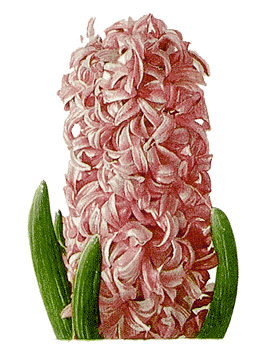Hyacinth, << HY uh sihnth, >> is a favorite spring flower. It originated in the Mediterranean region and Asia Minor (now part of Turkey), and was brought to western Europe in the early 1500’s. It is a popular plant. The bell-shaped flowers of blue, pink, white, yellow, or purple bloom from February to April on stalks 8 to 15 inches (20 to 38 centimeters) high.

Hyacinths grow from bulbs. They can be grown indoors or outdoors. When raised in the open, they need rich, well-drained soil. The bulbs are planted from September to November, depending on the climate. Early in the spring, the flowers appear. Gardeners sometimes tie the stems of hyacinths to slender stakes to protect them. After the plant flowers, gardeners remove the stalks and let the leaves die. This encourages new bulb growth.
Gardeners often force hyacinths to blossom before spring. To do this, they pot dormant (inactive) bulbs in a cold place in early fall, keeping them there for about 8 to 12 weeks. They then bring the bulbs into a warm place that receives sunlight. The bulbs blossom a few weeks later.
The soil and climate of the Netherlands provide an especially favorable place for growing the bulbs. The Dutch plant a large number of hyacinths every year near Haarlem. They ship these bulbs to many parts of the world for gardeners and florists to use.
See also Bulb .
